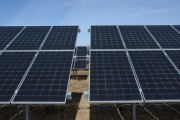This op-ed originally appeared in the National Observer on Nov. 8, 2021.
Last week at COP26, the United Nations climate conference, Canada’s Prime Minister Justin Trudeau joined the U.S. and United Kingdom in committing to a net-zero emissions electricity grid by 2035. He did so with little fanfare – but it was a monumental first step. A clean grid is so fundamental to succeeding in reaching net-zero by 2050, the International Energy Agency set 2035 as the target date for developed countries in its landmark Net Zero by 2050 report.
Delivering on this promise (made to Canadians on the campaign trail) will require considerable effort. Canada’s grid is a source of emissions and isn’t ready to meet growing demand. It is in desperate need of modernization to support the zero-emission economy Canada is trying to build.
How will Canada deliver this bigger, cleaner, modernized grid so we can electrify our vehicles, buildings and businesses, and take advantage of the opportunity to export in-demand clean electricity to our neighbours to the south?
We need to act quickly. Asset planning, development and turnover can take decades. If we don’t move swiftly now, we will lose windows of opportunity. Four key pieces of the puzzle include renewable energy to provide zero-carbon electricity, energy efficiency to reduce how much electricity is needed, demand response to match when electricity is needed with when it is available, and increased storage capacity. All of these fall within provincial jurisdiction. Provinces have the power – and responsibility – to drive solutions. That starts with committing to a net-zero grid and updating regulations to allow for greater integration of clean energy solutions.
But there is a fifth piece that is critical to bringing it all together: Canada needs more transmission lines to connect provincial grids and allow us, as a nation, to play to our strengths. Unlike the first four pieces of the net-zero grid puzzle, transmission requires interprovincial co-operation. The rewards for succeeding should not be underestimated.
Canada has tremendous renewable energy resources. Every province has wind and solar power, and some have an abundance of hydro power as well. A modernized grid with transmission interconnections for greater integration between provincial grids will allow for higher penetration of clean energy sources, and create conditions for these sources to work together at a large scale. With transmission lines connecting provincial grids, provinces could finally break free of geographic borders and take advantage of Canada’s clean energy strengths – delivering clean electricity where and when it is needed.
Whether to finish phasing out coal (as is the case in Alberta, Saskatchewan, New Brunswick and Nova Scotia) or, as in Ontario, to replace nuclear that’s being refurbished, several Canadian provinces are poised to make critical infrastructure investment decisions to ensure communities can heat their homes, light buildings and power businesses, farms and industry. And the reality is every province will have to meet increased demand for clean electricity as we strive to electrify everything. The decisions provinces make in the near future will not only shape electricity sectors and respective greenhouse gas emissions for decades to come, but also the carbon footprint of businesses and industries and the products they make for domestic consumption or to sell abroad.
Provinces don’t have to go it alone – nor could they. Instead they can create mutually beneficial arrangements to build regional interconnections and enhance interprovincial trade of electricity. This will help companies improve their environmental performance and ability to deliver on net-zero commitments, and it will enable municipalities to act on the climate emergency.
What’s more, studies by the Massachusetts Institute of Technology and National Renewable Energy Laboratory (a function of the U.S. Department of Energy) show that a widescale transmission buildout can deliver the benefits of a net-zero grid at a lower cost, using technologies that are ready to deploy at scale today.
It’s time for provinces and the federal government to play to our strengths as a nation and build the backbone of a low-carbon economy – a net-zero grid by 2035. Let’s get started now, for electricity consumers at home and to give Canadian goods a competitive edge abroad.









